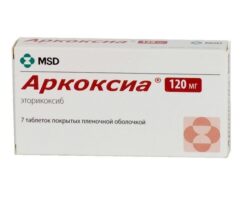-
×


-
×


-
×


Subtotal: €25.39






Subtotal: €25.39






Subtotal: €25.39
€16.45 €14.25
Out of stock
(E-mail when Stock is available)
Paracetamol is an analgesic and antipyretic. The mechanism of its action is presumably inhibition of prostaglandin synthesis, mainly in the central nervous system.
Paracetamol has an extremely small effect on the synthesis of prostaglandins in the peripheral tissues, it does not change the water-electrolyte metabolism and does not damage the mucous membrane of the gastrointestinal tract.
Eliminating cold and flu symptoms:
increased body temperature;
headache;
chills;
pain in joints and muscles;
nasal congestion;
sore throat;
pain in the sinuses.
A combined product whose effect is determined by its constituent components.
Paracetamol is an analgesic and antipyretic. The mechanism of its action is presumably to suppress the synthesis of prostaglandins, mainly in the central nervous system.
Paracetamol has an extremely small effect on the synthesis of prostaglandins in peripheral tissues; it does not change water-electrolyte metabolism and does not damage the mucous membrane of the gastrointestinal tract.
The patient should be informed that if symptoms persist after 5 days of using the drug, they should stop taking it and consult a doctor.
The drug should be taken only in recommended doses.
The drug should not be taken concomitantly with other drugs containing paracetamol, as well as other non-narcotic analgesics (metamizole sodium), NSAIDs (acetylsalicylic acid, ibuprofen), barbiturates, anticonvulsants, rifampicin and chloramphenicol, sympathomimetics (such as decongestants, appetite suppressants, amphetamine-like psychostimulants), with other drugs to relieve cold and flu symptoms.
When conducting tests to determine uric acid and blood glucose levels, the patient must inform the doctor about the use of the drug Coldrex® MaxGripp, because the drug may interfere with the results of laboratory tests assessing the concentration of glucose and uric acid.
Before taking Coldrex® MaxGrip, you should consult a doctor if:
– taking metoclopramide, domperidone (used to relieve nausea and vomiting) or cholestyramine, used to lower blood cholesterol levels;
-taking medications to reduce blood clotting (for example, warfarin);
– following a low-sodium diet – each sachet contains 0.12 g of sodium;
-severe infectious diseases (including sepsis) in patients with glutathione deficiency, because while taking paracetamol, the risk of metabolic acidosis may increase, signs of which are disturbances in the frequency and depth of breathing, accompanied by a feeling of lack of air (shortness of breath), nausea, vomiting, and loss of appetite. If the patient discovers these, you should immediately consult a doctor.
To avoid toxic liver damage, paracetamol should not be combined with alcoholic beverages, or taken by people who chronically drink alcohol.
Impact on the ability to drive vehicles and machinery
When taken in recommended doses, the drug does not affect the ability to drive vehicles and machinery, as well as engage in other potentially hazardous activities that require concentration and speed of psychomotor reactions. If dizziness occurs, it is not recommended to drive vehicles or operate machinery.
Paracetamol, Phenylephrine, [Ascorbic Acid]
Paracetamol;
Pregnancy
The drug should not be used during pregnancy without first consulting a doctor!
Animal and human studies have not shown any risk of using paracetamol during pregnancy or adverse effects on intrauterine development.
There is no sufficient data on the effect of drugs containing phenylephrine on the course of pregnancy.
The maximum daily dose of ascorbic acid during pregnancy is 2000 mg, which significantly exceeds the maximum daily dose of the drug, so taking the drug in pregnant women is presumably not associated with the risk of side effects from ascorbic acid.
Breastfeeding period
The drug should not be used during breastfeeding without first consulting a doctor!
Paracetamol penetrates the placental barrier and into breast milk. Studies conducted on humans have not shown any negative effects on the baby’s body during breastfeeding.
Phenylephrine may pass into breast milk.
The maximum daily dose of ascorbic acid during breastfeeding is 2000 mg, which significantly exceeds the maximum daily dose of the drug, so taking the drug in women during breastfeeding is not associated with side effects from ascorbic acid.
Hypersensitivity to the ingredients of the drug.
Pregnancy and breastfeeding.
Severe liver or kidney disease.
Diseases of the blood system.
Increased function of the thyroid gland (thyrotoxisis).
Arterial hypertension.
Heart diseases: severe stenosis of the aortic mouth, acute myocardial infarction, tachyarrhythmias.
Prostatic hyperplasia.
Angle-closure glaucoma.
Simultaneous use of tricyclic antidepressants, beta-blockers, MAO inhibitors and for up to 14 days after their discontinuation.
Diabetes mellitus and diseases associated with hereditary malabsorption of sugar – each sachet contains 4 g of sugar.
Genetic absence of glucose-6-phosphate dehydrogenase.
Age up to 18 years.
With caution:
Benign hyperbilirubinemia.
Determination of the frequency of side effects: very often (≥1/10), often (≥1/100 and <1/10), infrequently (≥1/1000 and <1/100), rarely (≥1/10,000 and <1/1000), very rarely (≥1/100,000 and <1/10,000).
At recommended doses, the drug is usually well tolerated.
Paracetamol rarely has side effects.
From the hematopoietic system: very rarely – thrombocytopenia, leukopenia, agranulocytosis.
Allergic reactions: very rarely – anaphylactic shock, skin rash, urticaria, angioedema, Stevens-Johnson syndrome.
From the respiratory system: very rarely – bronchospasm in patients sensitive to acetylsalicylic acid and other NSAIDs.
From the liver and biliary tract: very rarely – impaired liver function.
From the urinary system: with long-term use in excess of the recommended dose, nephrotoxic effects may be observed.
Phenylephrine
From the nervous system: very rarely – nervousness, headache, dizziness, insomnia.
From the cardiovascular system: very rarely – increased blood pressure, tachycardia, palpitations.
From the digestive system: very rarely – nausea, vomiting.
From the sensory organs: very rarely – mydriasis, acute attack of glaucoma in most cases in patients with angle-closure glaucoma.
Allergic reactions: very rarely – skin rash, urticaria, allergic dermatitis.
From the urinary system: very rarely – dysuria, urinary retention in patients with obstruction of the bladder outlet due to prostatic hypertrophy.
Ascorbic acid
The incidence of side effects has not been established.
Allergic reactions: skin rash, skin hyperemia.
From the digestive system: irritation of the gastrointestinal mucosa.
From the hematopoietic system: thrombocytosis, hyperprothrombinemia, erythropenia, neutrophilic leukocytosis.
Other: hypokalemia.
When taking ascorbic acid more than 600 mg/day, moderate pollakiuria is possible.
If side effects occur, the patient should immediately stop taking the drug and consult a doctor as soon as possible.
If any of the above side effects worsen, or any other side effects occur, the patient should inform the doctor.
Paracetamol, when taken for a long time, enhances the effect of indirect anticoagulants (warfarin and other coumarins), which increases the risk of bleeding. Occasional administration of a single dose of the drug does not have a significant effect on the effect of indirect anticoagulants.
Inducers of microsomal oxidation enzymes in the liver (barbiturates, diphenin, carbamazepine, rifampicin, zidovudine, phenytoin, ethanol, flumecinol, phenylbutazone and tricyclic antidepressants) increase the risk of hepatotoxicity in overdoses and concomitant use with paracetamol.
Microsomal oxidation inhibitors (cimetidine) reduce the risk of hepatotoxicity.
Paracetamol reduces the effectiveness of diuretics.
Metoclopramide and domperidone increase, and cholestyramine reduces the rate of absorption of paracetamol.
Paracetamol enhances the effects of MAO inhibitors, sedatives, ethanol.
Phenylephrine when taken with MAO inhibitors can lead to an increase in blood pressure.
Phenylephrine reduces the effectiveness of beta-blockers and antihypertensive drugs, increases the risk of developing arterial hypertension and disorders of the cardiovascular system.
Concomitant use of phenylephrine with sympathomimetic amines may increase the risk of adverse cardiovascular effects.
Tricyclic antidepressants enhance the sympathomimetic effect of phenylephrine and may increase the risk of side effects from the cardiovascular system.
Concomitant use of halothane with phenylephrine increases the risk of developing ventricular arrhythmia.
Phenylephrine reduces the hypotensive effect of guanethidine, which, in turn, enhances the alpha-adrenergic stimulating activity of phenylephrine.
Antidepressants, antiparkinsonian drugs, antipsychotic drugs, phenothiazine derivatives increase the risk of developing urinary retention, dry mouth, constipation.
Concomitant administration of GCS with phenylephrine increases the risk of developing glaucoma.
When used simultaneously with digoxin and cardiac glycosides, the risk of developing heart rhythm disturbances or a heart attack may increase.
Ascorbic acid increases the risk of developing crystalluria during treatment with salicylates and short-acting sulfonamides, slows down the excretion of acids by the kidneys, increases the excretion of drugs that have an alkaline reaction (including alkaloids), and reduces the concentration in the blood of oral contraceptives.
Ethanol contributes to the development of acute pancreatitis.
Myelotoxic drugs enhance the hematotoxicity of the drug.
In case of overdose of Coldrex® MaxGripp (even if you feel well), the risk of delayed signs of serious liver damage should be taken into account.
Overdose is usually caused by paracetamol. Liver damage in adults is possible when taking ≥ 10 g of paracetamol.
Taking ≥ 5 g of paracetamol may cause liver damage in patients with the following risk factors:
– long-term treatment with carbamazepine, phenobarbital, phenytoin, primidone, rifampicin, St. John’s wort preparations, or other drugs that stimulate liver enzymes;
-regular consumption of alcohol in excess quantities;
-glutathione deficiency (due to malnutrition, cystic fibrosis, HIV infection, starvation, exhaustion).
Symptoms (due to paracetamol): pale skin, nausea, vomiting, anorexia, abdominal pain are possible within 24 hours; within 12-48 hours, signs of liver dysfunction, signs of impaired glucose metabolism and metabolic acidosis may appear. In cases of severe poisoning, severe liver failure may occur, including hepatic encephalopathy, coma and death.
Paracetamol
Quickly and almost completely absorbed from the gastrointestinal tract, distribution in body fluids is relatively even.
Metabolized primarily in the liver with the formation of several metabolites.
T1/2 when taking a therapeutic dose is 2-3 hours. The main amount of the drug is excreted after conjugation in the liver. No more than 3% of the received dose of paracetamol is excreted unchanged.
Phenylephrine
It is poorly absorbed from the gastrointestinal tract and undergoes first-pass metabolism in the intestines and liver under the influence of MAO. When phenylephrine is taken orally, the bioavailability of the drug is limited.
It is excreted almost entirely in the urine as a sulfuric acid conjugate.
Ascorbic acid
Well absorbed from the gastrointestinal tract, binding to plasma proteins is 25%. Distribution in body tissues is wide.
Metabolized in the liver, excreted in the urine as oxalate and unchanged.
Ascorbic acid, taken in excessive quantities, is quickly excreted unchanged in the urine.
Coldrex MaxGrip is a combined drug, the effect of which is determined by the active components included in the composition:
Paracetamol has an analgesic and antipyretic effect.
Phenylephrine is a vasoconstrictor, relieves nasal congestion (narrows the vessels of the nasal mucosa and paranasal sinuses) and facilitates breathing.
Ascorbic acid (vitamin C) replenishes the need for vitamin C for colds and flu.
The active ingredients of Coldrex MaxGrip do not cause drowsiness.*
* Instructions for medical use, RU P N014920/01
If you have one of the following diseases/conditions/risk factors, be sure to consult your doctor before taking the drug:
Benign hyperbilirubinemia.
Mild to moderate liver and kidney dysfunction.
Acute hepatitis.
Alcoholic liver disease.
Difficulty urinating.
Pyloroduodenal obstruction.
Stenosing ulcer of the stomach and/or duodenum.
Bronchial asthma.
Cardiovascular diseases, including high blood pressure, occlusive vascular disease (Raynaud’s syndrome).
Pheochromocytoma.
The presence of severe infections, including sepsis, because taking the drug may increase the risk of metabolic acidosis.
Patients with glutathione deficiency (in particular, extremely malnourished patients suffering from anorexia, chronic alcoholism or patients with a low body mass index).
Concomitant use of antihypertensive drugs.
At a temperature not exceeding 25 °C
3 years
SmithKline Beecham S.A., Spain
| Shelf life | 3 years |
|---|---|
| Conditions of storage | At a temperature not exceeding 25 °C |
| Manufacturer | SmithKlein Beecham S.A., Spain |
| Medication form | Powder for preparation of solution for oral administration |
| Brand | SmithKlein Beecham S.A. |
Buy Coldrex MaxGrippe, lemon 6 g 10 pcs with delivery to USA, UK, Europe and over 120 other countries.